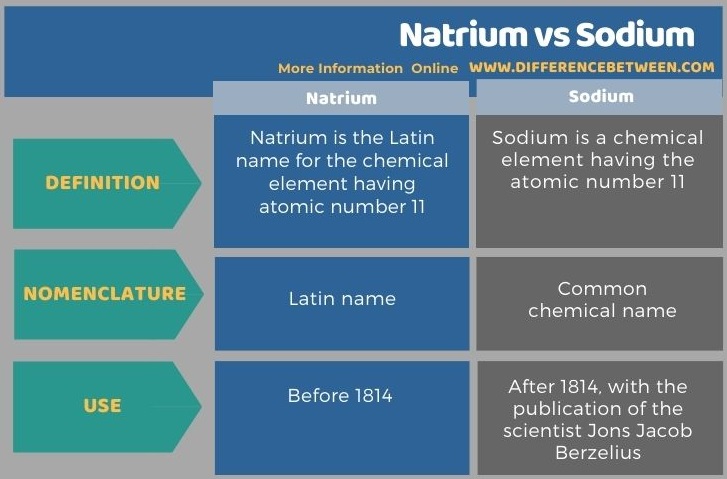Difference Between Natrium and Sodium
The key difference between Natrium and Sodium is that Natrium is the Latin name for the chemical element having the atomic number 11 whereas sodium is the common name for the same chemical element.
Both names, Natrium and sodium, refer to the same chemical element but they are used differently; sodium is the common name for this chemical element but Natrium is the Latin name from which the symbol of this chemical element is derived, “Na”.
CONTENTS
1. Overview and Key Difference
2. What is Natrium
3. What is Sodium
4. Relationship Between Natrium and Sodium
5. Side by Side Comparison – Natrium vs Sodium in Tabular Form
6. Summary
What is Natrium?
Natrium is the Latin name for the chemical element having atomic number 11. The common name for this chemical element is sodium, as published in 1814 by Jons Jacob Berzelius. The Latin name Natrium refers to the Egyptian natron, which is a natural mineral salt mainly consisting of hydrated sodium carbonate. The chemical symbol for sodium is Na. This comes from the first two letters of the name Natrium.

Figure 01: Na
What is Sodium
Sodium is a chemical element having atomic number 11. The chemical symbol for sodium is Na, which comes from its Latin name Natrium. This chemical element is located in group 1 and period 3 of the periodic table of elements. Therefore, it is an s-block element. We can categorize sodium as an alkali metal because it is a group 1 metal. The electron configuration of sodium is [Ne]3s1. Therefore, we can determine that the valency of sodium is 1. This means one sodium atom can remove one electron in order to get stable, noble gas electron configuration.
The free sodium metal does not occur in nature due to its high reactivity. It occurs as salts of sodium from which we can extract the pure metal. Sodium can be recognized as the 6th most abundant element on Earth’s crust. The major minerals in which sodium occurs include feldspar, sodalite, and rock salt. Almost all sodium salts are water-soluble. Upon dissolution, these salts form sodium cation having +1 electric charge.

Figure 02: Sodium Pure Metal
This metal is considered as an essential element for animals and some plants. For example, the sodium cation is the major cation in extracellular fluid in animals. Other than that, metallic sodium is important for the production of sodium-containing compounds such as sodium chloride, sodium hydroxide, and sodium carbonate, which are produced annually for different needs. Moreover, metallic sodium is useful in the production of sodium borohydride, sodium azide, indigo, and triphenylphosphine. In addition, sodium is used as an alloying metal for anti-scaling agents.
What is the Relationship Between Natrium and Sodium?
- Both Natrium and sodium refer to the same chemical element; Natrium is the Latin name from which the chemical symbol originates from, while Sodium is the common name.
What is the Difference Between Natrium and Sodium?
The key difference between Natrium and sodium is that the term Natrium is the Latin name for the chemical element having atomic number 11 whereas the term sodium is the common name for the same chemical element. The name Natrium was used before 1814, but after the publication of the scientist Jons Jacob Berzelius, it began to be known as Sodium.

Summary – Natrium vs Sodium
The terms sodium and Natrium come in inorganic chemistry. The key difference between Natrium and sodium is that the term Natrium is the Latin name for the chemical element having atomic number 11 whereas the term sodium is the common name for the same chemical element.
Reference:
1.“Sodium – Element Information, Properties and Uses: Periodic Table.” Royal Society of Chemistry, Available here.
Image Courtesy:
1. “Sodium” By Albedo-Ukr – Image:Sodium.gif (CC BY-SA 2.5) via Commons Wikimedia
By The original uploader was Dnn87 at English Wikipedia. – Transferred from en.wikipedia to Commons (CC BY-SA 3.0) via Commons Wikimedia
ncG1vNJzZmivp6x7pbXFn5yrnZ6YsqOx07CcnqZemLyue8OinZ%2Bdopq7pLGMm5ytr5Wau266wK2poq2dYq6vsIyspp2hpaJ8